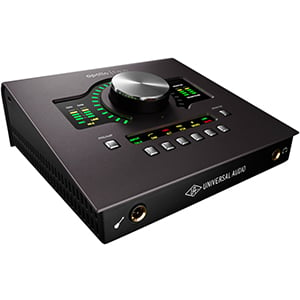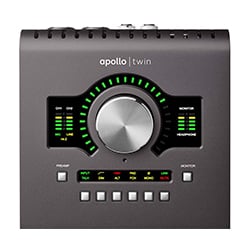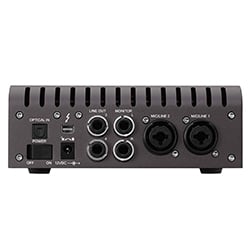- Home
- Instruments
- Gear
- Recording
- Lessons
- Reviews
- Blog


| Design: |  |
| Features: |  |
| Performance: |  |
| Value: |  |
Universal Audio’s Apollo Twin MkII Duo builds on the success of the original Apollo Twin, and – as such – proves to be one of the most popular high-end audio interfaces you can find on the market today. On the face of it, it’s a simple interface… too simple? Let’s take a closer look and find out!

With the Apollo Twin MkII Duo, we have a high-end audio interface that really doesn’t look like the other high-end interfaces you may have come across. It features a very attractive, almost boutique-style design. Compared to others in this range, it is very compact (around 6” by 6”) with a sturdy chassis crafted from thick aluminum.
Slanted towards you, all of the controls are located on the top panel, while the inputs and outputs are distributed between the front and back of the unit. You would be mistaken for considering the Apollo Twin MkII Duo too simple to be worthy of a professional studio, although you would be wrong – as we will find out, this unit gets the job done!

In terms of features, the Apollo Twin MkII Duo uses Thunderbolt as its connection of choice, which means you can expect a high bandwidth and almost no latency when monitoring (it’s a shame there’s no included Thunderbolt cable, but it’s not a deal-breaker).
Moving onto the inputs, it’s not as well stocked as others in the under-$1,000 category, but still offers three analog inputs – comprising two XLR/TRS combos and a dedicated Hi-Z TRS for instruments – as well as a pair of 1/4” monitor and 1/4” line outputs. It also comes with one ADAT digital input, which enhances the flexibility a little.
The premium preamps built into this audio interface are top tier and implement UA’s Unison modelling technology, while the brand redesigned their A/D converters in a way that yields a much smoother performance and a resolution of up to 24-bit/192kHz. One of the more interesting features is the UAD-2 processing support, which means that you can access a whole variety of plugins in an instant.
While this interface looks simple, simple is sometimes the best choice. It is so tightly focused that it does less than other interfaces – but what it does it does well!
The preamps offer some of the best sounds you can find in this higher-end price range, while the Thunderbolt connectivity and UAD-2 processing means that you can apply a whole array of plug-ins and monitor their effects in real-time. While this interface doesn’t come with a DAW, it is optimized to work flawlessly with all major DAWs on the market, as well as both Mac and Windows. Very impressive.
Universal Audio’s reputation is great and this is largely down to their logical and practical approach to designing their gear. The Apollo Twin MkII Duo is a perfect example of this – it does the essentials very well indeed, offering crystal clear audio and a simple operation, while still proving versatile and an overall workhorse. It won’t appeal to engineers and producers who need a mammoth list of connections, but for serious home studios or on-the-go users it’s a big winner.
For more info about the Universal Audio Apollo Twin MKII DUO, click here.
For more Audio Interfaces Under $1000 you might like, click here.

Reader Interactions